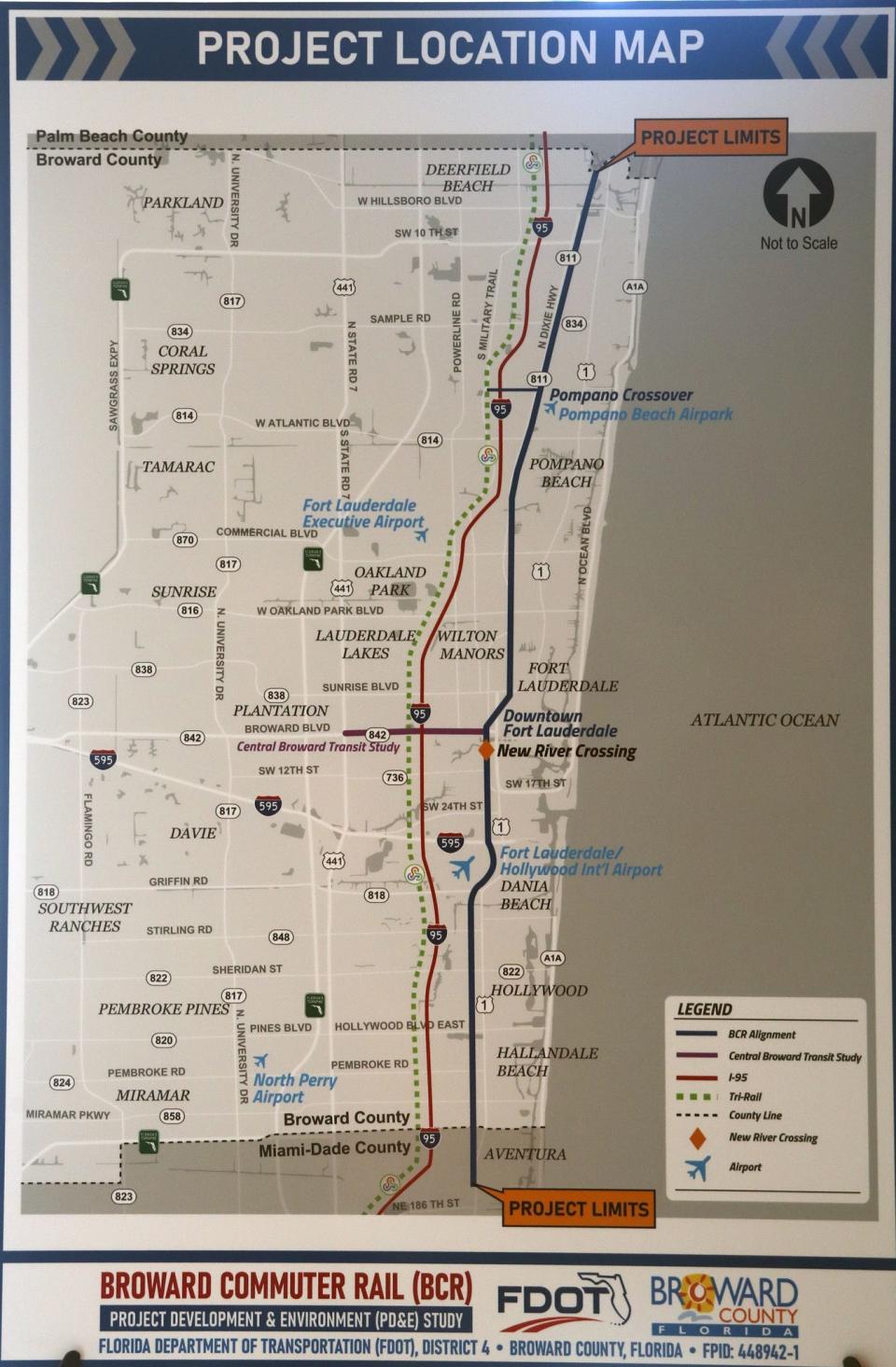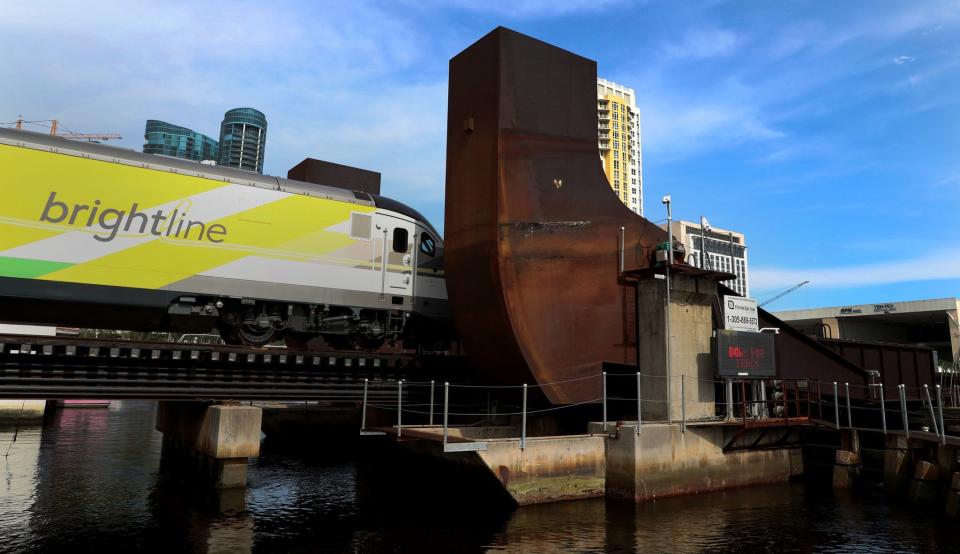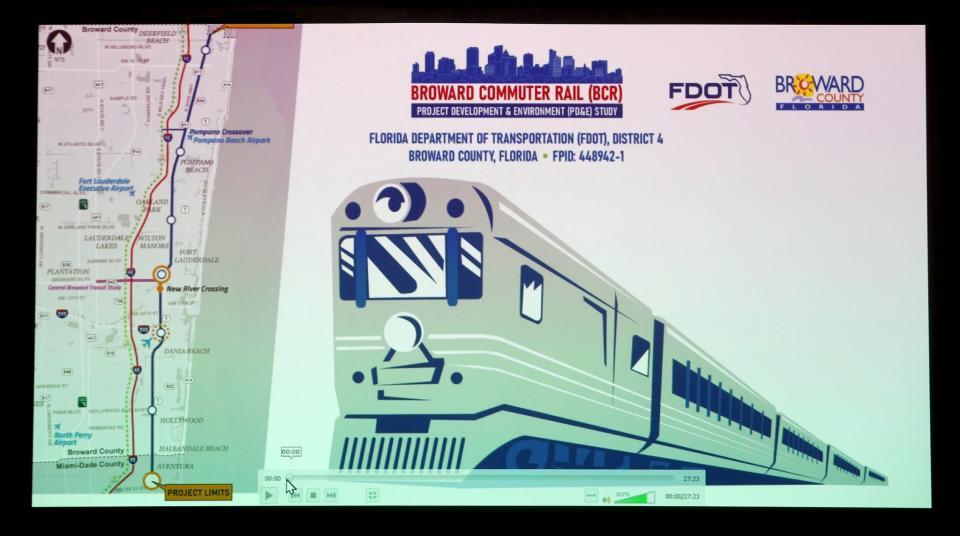Coastal commuter rail has long been planned for South Florida. Will Broward lawmakers push it forward?
Interstate 95 wasn’t built all at once. And a proposed commuter rail line that would run through Broward County along the Florida East Coast Railway won’t materialize quickly, either.
State and local planners remain unable to decide whether trains would pass over or under the New River in Fort Lauderdale.
So the county commission is poised Thursday to set aside the river crossing question and proceed with a southern leg that would stretch from Aventura to Hollywood and past the Fort Lauderdale-Hollywood International Airport with an end point just south of the river near the Broward Health Medical Center.
The lawmakers will vote on a resolution that would provide $15.5 million for initial development costs and an environmental study. The measure would also direct the county to seek grant money to fund the project.
“They’re green-lighting it,” said Gregory Stuart, executive director of the Broward Metropolitan Organization, which helps arrange federal funding for county transportation projects. “All of the necessary steps from here are going to be environmental and engineering and construction, and looking for the operator. They’re ready to rock and roll.”
“This is a really big step in getting them ready to receive federal money to help the project move forward,” he added.
The total cost, according to Stuart: $345 million, which he said is roughly the cost of revamping an I-95 interchange.
The county administration has recommended that the commission approve the proposal to start the southern segment first.
Two decades in the making
The planned rail line is part of Broward’s portion of the long-awaited “Coastal Link” tri-county commuter rail initiative that was launched almost 20 years ago, according to a staff memo to the commission.
The idea is to hitch a Broward segment along the Florida East Coast line with a proposed leg between Aventura and downtown Miami that’s been endorsed by Miami-Dade County officials.
Since the commuter idea arose, the higher-speed Brightline appeared on the scene, and started service to Miami, Fort Lauderdale and West Palm Beach with intentions to added a line to Orlando next year. It is currently building stations in Aventura and Boca Raton.
The coastal link trains would also stop in Aventura, but would be run by another operator.
In January 2021, Broward County and Florida Department of Transportation agreed to collaborate on project development and environmental studies, financial planning and community outreach. The FDOT conducted a numbers of studies along the 27-mile corridor in Broward, identifying potential stations between Aventura and Deerfield Beach, as well as options for phasing in the project.
But there’s been one continuous snag: How to get the trains across the New River in downtown Fort Lauderdale.
Currently, passenger trains operated by the Brightline inter-city passenger line and freights run by the Florida East Coast Railway rumble across a drawbridge just south of Broward Boulevard. When the span is lowered for trains, it stops boating traffic on the river, a long-standing sore point for the Marine Industries Association of South Florida.
Among other things, the trade group argues, the delays are costly not only for recreational boaters but for vessel operators sailing to and from marine businesses to the west.
FDOT, after taking stock of the feedback from various boating and other interests, served up four alternatives: three levels of fixed bridges and a tunnel. The agency decided more studies are needed.
Crossing solution would come later
So at a mid-June workshop, the Board of County Commissioners decided to proceed with a southern segment “which will not require crossing the New River,” the staff memo says.
“Phased development is a normal approach used in developing public transit systems in the U.S. and around the world,” the memo to the commission says. “Experience from other U.S. counties and cities shows that starting with smaller initial projects can help demonstrate benefits and generate greater support and momentum needed to achieve consensus for subsequent projects and phases of development. "
In an interview Tuesday, Broward Mayor Michael Udine told the South Florida Sun Sentinel that he agrees.
“As we look forward with this, we can do the southern thing,” Udine said. “Miami-Dade has it in place. It’s something that’s doable. You have the tracks there. You probably don’t need such an extensive environmental study. There’s probably federal dollars, so let’s get it built … let’s take half a bite of the apple now and we’ll probably do something on the northern side, too, if we can hook in with Palm Beach [County].”
“Ideally we need to figure out a way to deal with the New River,” he added. “When they built I-95 they didn’t build it from the Northeast to Key West all at once.”
Hollywood Mayor Josh Levy, who has been advocating that the southern segment become the first step for the rail line, wants to get the project started sooner than later. As with other South Florida cities, Hollywood is in the midst of a commercial and residential development surge, and he would like to see trains serving his downtown.
Under the proposed plan, there would be a commuter station at Tyler and Taylor streets.
“It’s exciting because the new direction will accelerate the introduction of Broward commuter rail,” he said. “We all know the crossing of the New River will take many years to construct whether it is over or under [the river].”
Fort Lauderdale wants tunnel included
But Fort Lauderdale Mayor Dean Trantalis said in a telephone interview Wednesday that while he believes the southern link “is an important first step,” he would have preferred that the county make a tunnel part of its preferred plan.
“I feel that by not including the New River crossing, the county is simply kicking the can down the road,” he said.
To omit a tunnel, he said, poses the risk of losing federal funding that might evaporate with the progression of time.
“Instead of trying to avoid the issue we need to partner and move forward using the tunnel as part of the application for the federal funding,” Trantalis said.
Failing to do so, he added, is “only going to put the entire project at risk.”
Staff writer David Lyons can be reached at dvlyons@SunSentinel.com



